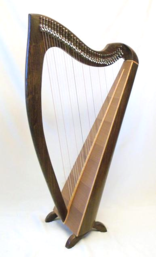Tonewoods
Fisher Harps
Engelmann Spruce - Rocky Mountains of British Columbia, Canada. This spruce is a popular soundboard wood for North American stringed instrument makers, and has a tone similar to European White Spruce. It has a light, creamy colour, and is harder and stiffer than cedar.
The tone it produces is round, open & full with a good, clear treble and is more or less evenly balanced between the treble and bass. Spruce can sometimes take up to a year to develop it full tone.
Western Red Cedar - Coastal British Columbia, Canada. The cedar that I use is eco-friendly salvaged timber. This variety of cedar is light brown to dark brown in colour and sometimes has colour variations running through it. Western red cedar is popular with classical guitar makers and I've found it especially suitable for the small Celtic harp.
Cedar is known for its volume, warmth, wealth of harmonics (overtones) and 'bass-iness'. What is most characteristic of cedar is that it takes only a short time for the voice to mature, and can even sound 'played-in' when new.
Special note: I'm currently able to obtain some nice salvage cedar from Haida Gwaii (Queen Charlotte Islands).
Lighter coloured cedar
Darker coloured cedar

